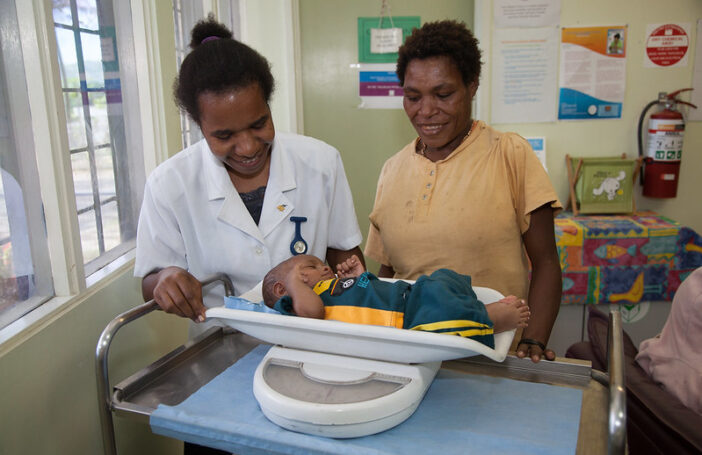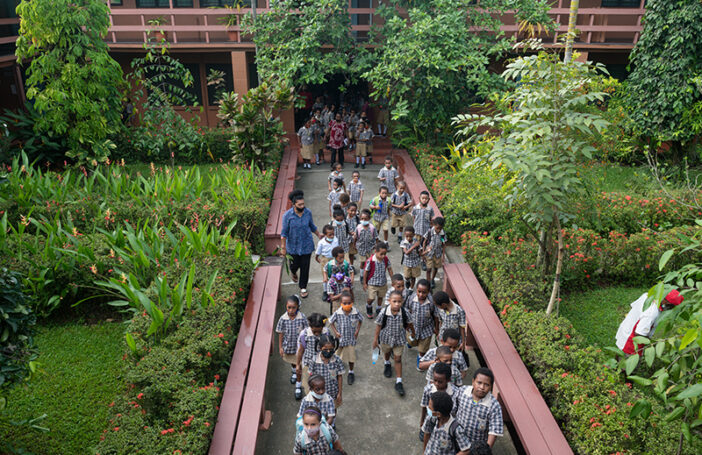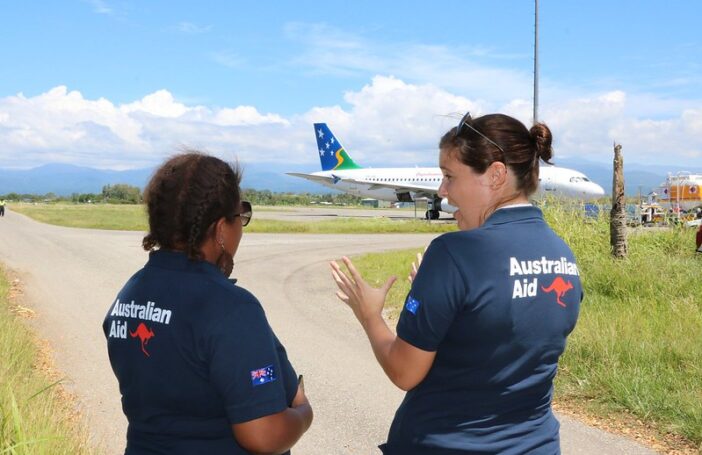Neither Fiji nor Papua New Guinea, the two economic giants of the Pacific, has been able to increase spending to respond to the health or the economic fall out of the COVID-19 pandemic and recession.
In both countries, after adjusting for inflation, spending in 2021 will be about the same as it was in 2019. The consistency of spending before COVID-19 (2019) and after the onset of the pandemic (2021) across both countries over the three years is quite remarkable, and clearly evident from the graph below. (2020, though not shown, is hardly different either.)
What the graph also makes clear is that the situation in both Fiji and PNG is very different to that here in Australia, where the government has engaged in a massive spending splurge, increasing spending by about 39% to protect Australians against the pandemic downturn.
That’s a 39% increase in government expenditure in Australia after the onset of COVID-19, versus no increase at all in Fiji and PNG.
Government expenditure in Fiji, PNG and Australia, before and after the onset of COVID-19
Fiji has been harder hit than PNG by COVID-19. In 2021, Fiji’s economy (as measured by its GDP) is projected to be only three-quarters of its 2019 size. PNG on the other hand is projecting a bounce-back and recovery with GDP in 2021 back to its 2019 level.
The Fijian government estimates that 115,000 Fijians are unemployed or on reduced hours, one-third of the workforce. According to the Fiji Hotel and Tourism Association, about 25,000 employees in Fiji’s tourism sector have lost their jobs and 279 hotels and resorts have been closed down. A World Bank survey of PNG indicated that 28% of households have cut back on food consumption to cope with the economic downturn.
Why, given all this suffering, is neither country spending more in response to COVID-19? The first reason is that both have experienced declines in revenue. Fiji’s revenue in 2021 is projected to be only half of its 2019 level. PNG, its economy less hard hit, has suffered a smaller hit, but its 2021 revenue will still be 8% below its 2019 level. Neither country is aid dependent, and neither is projecting an increase in donor grants.
The only other way to finance expenditure is through borrowing. Fiji is pulling out all stops. It plans to increase borrowing by a factor of almost five. In fact, in 2021, Fiji will be funding the majority of its expenditure by borrowing – 55%. PNG had higher borrowing to start with and is increasing it by a smaller amount – 50%. Even so, PNG plans to finance one-third of its expenditure via borrowing in 2021. And it is borrowing as much as it can. Indeed, whether PNG can meet its borrowing target for 2021 remains to be seen.
Australia is able to do much better (spend much more) because, like PNG, it is only suffering a small revenue cut, and, like Fiji, it is able to borrow a lot. In fact, Australia’s revenue in 2021 is only projected to be 3% below its 2019 level. But its borrowing has gone up from zero to 30% of total expenditure.
The graph below shows this story in columns.
The financing of expenditure in Fiji, PNG and Australia, via revenue, aid and borrowing, 2019 and 2021
Note: Australia’s borrowing in 2019 was -0.4% of expenditure.
The implications of this analysis are profound. Put simply, there is a lot of suffering in Fiji and PNG as a result of the economic downturn, and little either government can do about it.
Australia has become a strong advocate for the strengthening of safety nets in the Pacific, recently calling for consultants to bid on a contract to “nudge” (i.e. influence or lobby) Pacific governments to spend more in this area. But the question Australia needs to ask is: if Pacific governments spend more on safety nets, what will they spend less on? I don’t doubt that there are lower priority areas that could and should be cut to make way for greater safety net spending, but I am sceptical that in this time of uncertainty and suffering we will see substantial expenditure restructuring.
The fiscal situation in Fiji and PNG is dire, and the lack of an expenditure response is completely incommensurate with the suffering both are experiencing. The most practical support Australia can provide to these two countries is, first, to facilitate the reopening of international borders, and, second, to provide cheap, multi-year budget support.
The data used in this blog are contained in our latest version of our Pacific COVID-19 Economic Database. The fiscal year in Fiji runs from August to July; in Australia, from July to June; and in PNG, from January to December. For Australia and Fiji, 2019 is short for 2018-19.







Noting your article about Fiji and PNG …one of the distinctive features of both countries, which is not true of Australia, is that they are essentially agricultural societies where primary survival resources (in the form of food and housing) come from the land. It would be of interest to know how many local people have returned to their village communities as a means of being sustained during the pandemic. These things are not measurable in economic charts. I know more about the situation in Vanuatu than I do about Fiji and PNG, but in Vanuatu people who were in the urban areas and found themselves without financial income went back to their villages to maintain a sustainable life-style. Where that didn’t happen, family members from village communities provided increased food supplies to their family in the urban areas. The Vanuatu Govt formally encouraged this so as to avoid the financial impact of unemployment generated by the pandemic, in particular in the tourism industry.
There is really no equivalent to this in Australia …although we have heard anecdotally that people who have been laid off work, or who have had to remain at home, have spent more time in their gardens growing their own food.
Thanks for your work and the various articles that are sent via the DevPolicy site.
Randall Prior
(Chair, SWP Support Group, Victoria)